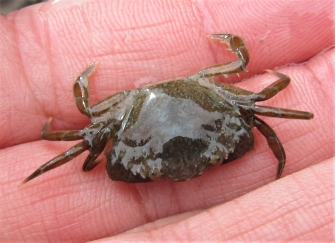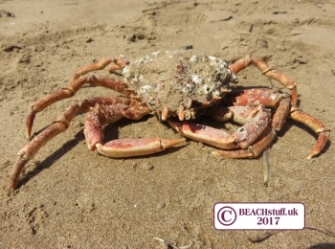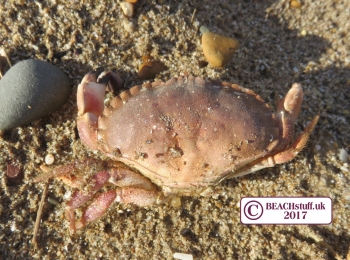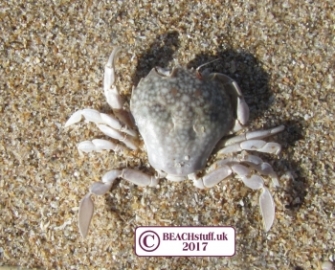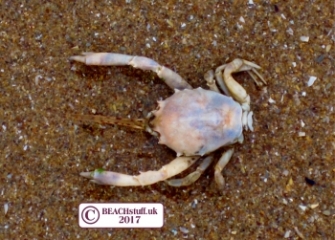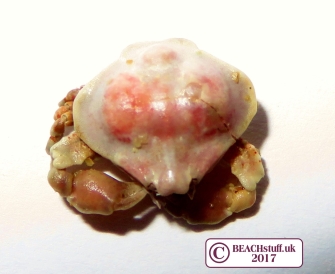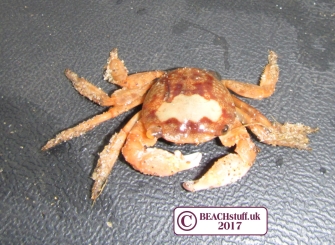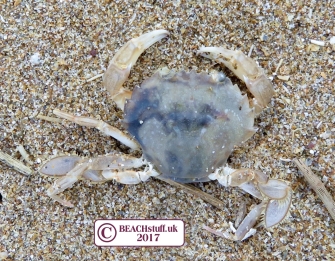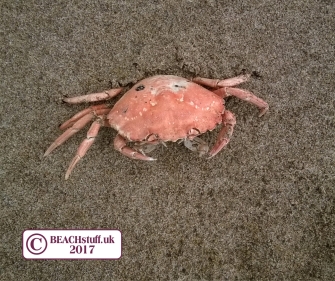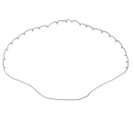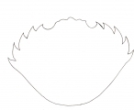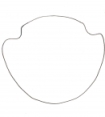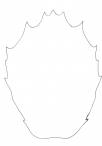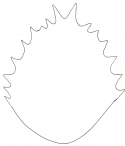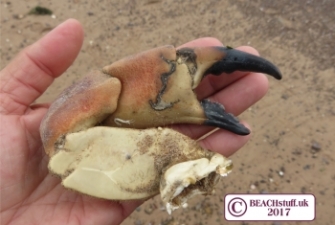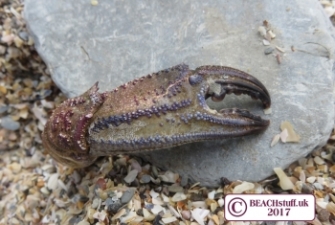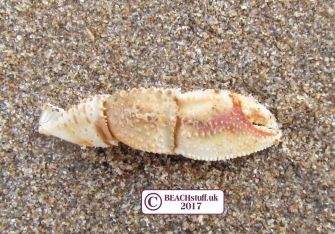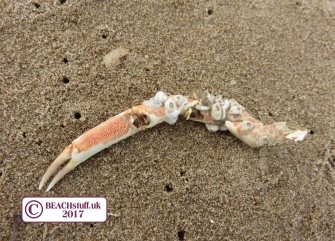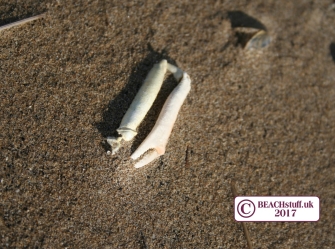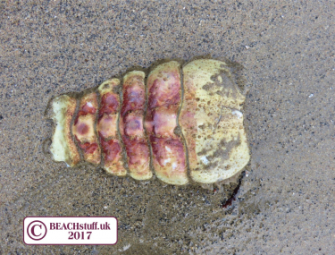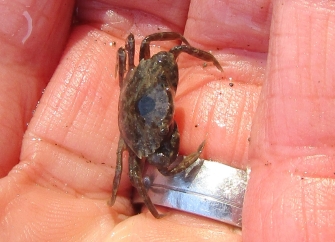

Crabs
Many of the crabs we find on the strandline are already dead or are the moulted shells discarded by growing crabs. (For more on crabs moulting visit this page)
Sometimes, we find only pincers, legs or the top part of the crab's carapace (shell). See our gallery below for help with the identification of these separate bits and pieces.
These are the main crabs you are likely to find on the beaches of Britain.
Shore Crab
Carcinus maenas
aka Green Crab, Green Shore Crab

TO THE RESCUE!
If you do find a live crab, the best thing that you can do for them is to get them into sea water, preferably in the relative calm of the deepest rock pool you can find. They will then try to find shelter under a rock or dig themselves into the sand.
If you cannot find a rockpool, dig a shallow hole and place the crab in the damp shade inside it.
CLICK PLAY TO WATCH THE VIDEO
Spider Crab
Maja squinado
aka European Spider Crab, Spiny Spider Crab, Spinous Spider Crab
TOP TIP! Lots of crabs are called spider crabs especially overseas - it can be a confusing chaotic world of long legs and crusty shells. To add to the confusion, crabs called Crab Spiders are also common in the UK (and overseas...)

The carapace is round and domed but may be so covered in seaweed and barnacles (the way the crab camouflages itself) that it can be hard to spot. Their long slender orange legs can be a give away though. The crabs often live in large communities just our to sea.
The bodies of the spider crab can grow to be as large as a dinner plate.
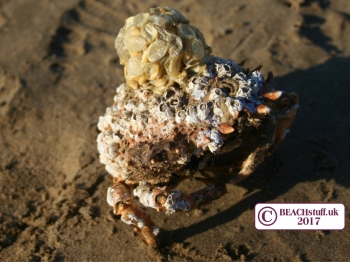
No need to be dowdy...
This spider crab was carrying not only a large collection of crenate and wart barnacles and keel worms but it also sported a dapper hat of whelk eggs.
Rescuing a spider crab from the strandline. Often they are already dead by the time we find them but this one moved a little so I thought it was worth running down to the water's edge with him.
CLICK PLAY TO WATCH THE VIDEO
Edible crab
Cancer pagurus
aka Brown Crab

A very tiny baby edible crab

The large front pincer claw of a grown edible crab
Not only is this crab given the name 'edible', it also has the misfortune to look a lot like a Cornish pasty - a toasted brown colour with nicely pinched pastry edges. In an English seaside restaurant or chip shop, ordering crab more than likely means that it is this crab that you will be served. In France, spider crabs are more the more popular crab dish. Edible crabs are quite shy and live hidden in our rock pools-they can grow to be almost 30 cm wide (edge of shell to edge of shell)
Pennant's Swimming Crab
Portumnus latipes
The white spots on the carapace of the Pennant's Swimming Crab are a good way of identifying it. It has flattened back legs which help it to swim but which are also good for digging backwards into wet sand where it likes to hide - have a look at the video below. Compare these back legs to the ones of the shore crab or spider crab above which are pointed and thus far better for grabbing and holding prey.
I believe that Mr Pennant was the chap who discovered this particular swiming crab. I hope that should I ever discover a crab, I would be a bit more imaginative with naming it. BeachStuff's Swimming Crab?
CLICK PLAY TO WATCH THE VIDEO
Masked Crab
Corystes cassivelaunus
aka helmet crab, sand crab
Rarely seen aliveon the beach as it lives buried in the sand with only its antennae at the surface of the sand. With the tube that these make, it can draw down sea water enabling it to breathe under the sand.
The males have these long pincers shown above while the females' front claws are pretty short as in the photo below.
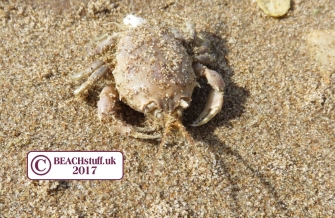
Bryer's Nut Crab
Ebalia tumefacta
This fabulous-looking crab looks very exotic but it is actually not uncommon on the west coast of Scotland and Wales and southern England. I've only ever found a couple of these and sadly one was dead, although perfectly preserved. They are small, only about 1cm across.
Before you ask, I have no idea who Bryer was or why he chose to immortalise his nut in this fashion.
Angular Crab or Square Crab
Goneplax rhomboides
This is an unusual find! It burrows into muddy sand. This one was seen by Sydney - many thanks are due to him for the photo.

Columbus Crab
Planes minutus
aka Gulf-weed crab
The Columbus Crab, thought to have first been seen by Christopher Clumbus, arrives clinging onto Goose Barnacles. Having travelled the oceans, it must be confusing landing on our beaches. Very small (around a centimetre wide), their bodies are almost square. Its preferred food is the sargassum weed.
Long-legged spider crab
Macropodia rostrata
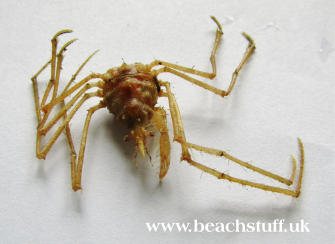
In comparison with the Common Spider Crab,this is a very small crab, the carapace only reaching 2cm in length. Like the Common Spider Crab, it gathers seaweed on its shell and legs which serve to enable to hide effectlvely.
Furrowed Crab
I have found a few of these stranded on sandy beaches but they actually live at sea, beyond the usual low tide level. They bury themselves in sand with often only their huge oversized claws showing. This is a useful stance both for defence and for catching passing prey.
Long-clawed Porcelain Crab
The Porcelain Crab has an almost round carapace with proportionately very very long and broad pincers. It is a small crab, only growing to about 1cm across.
Flying Crab
You won't be surprised to learn that this crab doesn't actually fly, but it is a very good swimmer. This small (up to 4cm across) crab has very large paddles on its back legs which make it an excellent swimmer.
This crab is sometimes confused with the Harbour Crab which looks very similar but has a row of white specks on its upper carapace.
Harbour Crab
This crab is not dissimilar to the Flying Crab (see above) but can be distinguished by the white spots in two curved lines half way down its carapace.
The orange colour in this specimen is not unusual in beached crab shells which have been hanging around for some time. The original crab was probably a much duller shade.

Nipper Swimming Crab
Also known as Henslow's Crab, this crab is found out in the deep Atlantic swimming near the surface of the sea where it feeds on squid, fish and other crabs. You can see how good a swimmer it is by the huge paddles on its back legs.
It is unusual to find one on the beach but Oliver did just that at Saunton Sands in North Devon.
Hermit Crab
Hermit crabs are not usually seen like this - they normally have a sea shell for protection. This one may have perished having left his shell (perhaps to try a new one for size) or may have died and then fallen out. He was a fine fella when he was alive though.
Below is a video of a smaller, but very much more alive hermit crab.
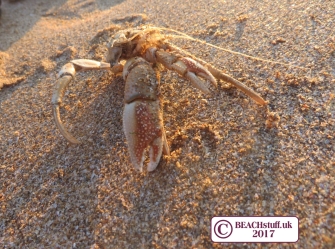
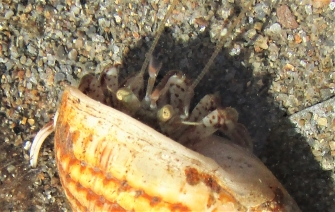
CLICK PLAY TO WATCH THE VIDEO
Lobsters
Lobster are related to crabs, all being crustaceans (along with prawns and shrimps - as well as woodlice and barnacles). When they are alive, they are this bright blue colour. Their shells, or parts of the their shells (like this tail that Christine Keay found) often wash up as they are discarded when the lonster moults.
When a lobster is cooked, they turn pink like the tail shell below which was chucked back on the beach.
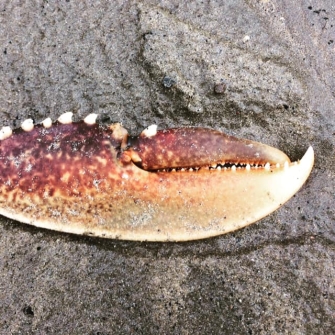

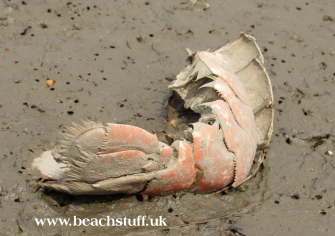
Still not sure? Have another look at some of the most common carapace shapes.
Identifying crabs without the carapace
Edible crab
The pincer of the edible crab is distinguishable from others by its very broad structure, orangey colour and the black teeth of each pincer.
These claws tend to look more 'muscular' and strong than other claws and this one in the photo is a whopper - as big as my hand.
Velvet Swimming Crab
A pimply claw with a purple/bluish hue is generally the pincer of a velvet swimming crab.
Hermit Crab
Another pimply claw - this time in beige and brown and orange. Quite a flat pincer, roundish in appearance. The common Hermit Crab will have just one claw like this - the left is smaller and narrower.
Spider Crab
The legs of spider crabs are very long and thin with dainty black points at the end of each. They may, if not bleached by the sun, still have patches of orange.
Spider Crab
Like its legs, the pincer of spider crab is recognisable as it is so long and thin. The pincers themselves are quite smooth and pointed.
This particular claw is now covered in barnacles.
Masked Crab
While the pincer of the Masked Crab is long and slender like those of the Spider Crab, it is not quite so pronounced - not as long and not as thin.
Looking at them together (spider crab pincer above), the difference is quite noticeable. A bit more practoce might be needed out on the beach.
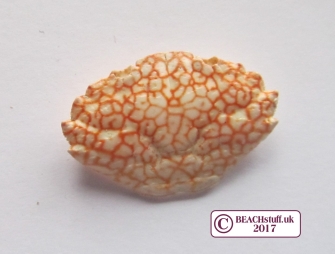
Marbled Swimming Crab
A beautiful carapace!
Crab Abdomen
This is the abdomen of a crab - most likely an edible crab. It is this flap which lifts up in a female crab when she is carrying eggs underneath it.

